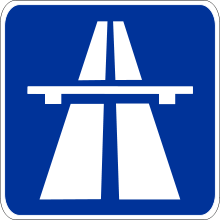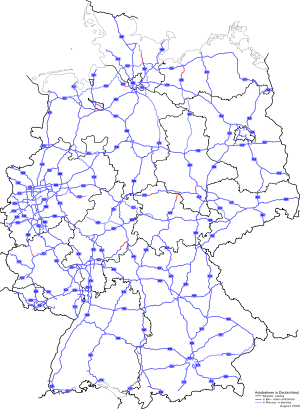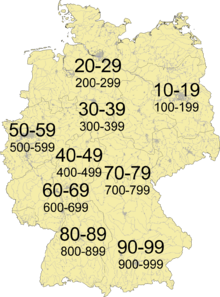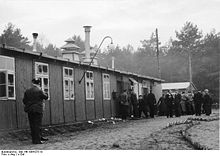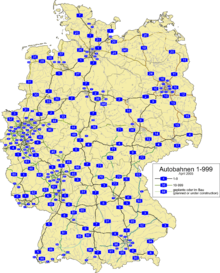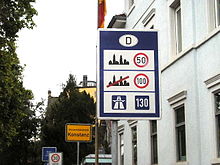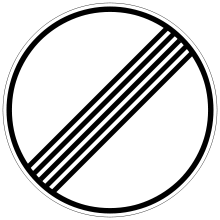- German autobahns
-
"Autobahn" redirects here. For other uses, see Autobahn (disambiguation).
The German autobahns are the nationally coordinated motorway system in Germany. In German, they are officially called Bundesautobahn (plural Bundesautobahnen, abbreviated BAB), which translates as federal expressways. German autobahns have no general speed limit, but the advisory speed limit (Richtgeschwindigkeit) is 130 kilometres per hour (81 mph).
Germany's autobahn network has a total length of about 12,800 km, or 7,950 miles (in 2010), which ranks as the fourth-longest in the world behind the Interstate Highway System of the United States, the National Trunk Highway System (NTHS) of the People's Republic of China and the National Highway of India. [1]
Contents
Name
These motorways are officially named Bundesautobahn (BAB), as they are built and maintained by the federal government. In the 1920s and 1930s, the official name was Reichsautobahn. The word Bahn (track) is the same as in Eisenbahn (railway) and refers to the course of the way through the landscape.
Construction
Similar to such motorways in other countries, autobahns have multiple lanes of traffic in each direction, separated by a central barrier with grade-separated junctions and access restricted to motor vehicles with a top speed of more than 60 km/h (37 mph). The earliest carriageways were flanked by shoulders about 60 centimetres (24 in) in width, constructed of varying materials; right-hand shoulders on many autobahns were later retrofitted to 120 centimetres (47 in) in width when it was realised cars needed the additional space to pull off the autobahn safely. In the postwar years, a thicker asphaltic concrete cross-section with full paved hard shoulders came into general use. The top design speed was approximately 160 km/h (99 mph) in flat country but lower design speeds could be used in hilly or mountainous terrain. A flat-country autobahn constructed to published design standards in use during the Nazi period could support speeds on curves of about 150 km/h (93 mph).
The current autobahn numbering system in use in Germany was introduced in 1974. All autobahns are named by using the capital letter A, which simply stands for "Autobahn" followed by a blank and a number (for example A 8). The main autobahns going all across Germany have a single digit number. Shorter autobahns that are of regional importance (e.g. connecting two major cities or regions within Germany) have a double digit number (e.g. A 24, connecting Berlin and Hamburg). The system is as follows:
- A 10 to A 19 are in eastern Germany (Berlin, Saxony-Anhalt, parts of Saxony and Brandenburg)
- A 20 to A 29 in northern and northeastern Germany
- A 30 to A 39 in Lower Saxony (northwestern Germany)
- A 40 to A 49 in the Rhine-Ruhr Area
- A 50 to A 59 also in the Rhine-Ruhr Area
- A 60 to A 69 in Rhineland-Palatinate, Saarland and Hesse
- A 70 to A 79 in Thuringia, northern Bavaria and parts of Saxony
- A 80 to A 89 in Baden-Württemberg
- A 90 to A 99 in (southern) Bavaria
There are also very short autobahns of just local importance (e.g. ring roads or the A 555 from Cologne to Bonn) that usually have three numbers, the first one of which is similar to the system above, depending on the region. East-west routes are always even-numbered, north-south routes are always odd-numbered.
The north-south autobahns are generally numbered using odd numbers from west to east; that is to say, the more easterly roads are given higher numbers. Similarly, the east-west routes are numbered using even numbers from north (lower numbers) to south (higher numbers).
History
The idea for the construction of the autobahn was first conceived during the days of the Weimar Republic, but apart from the AVUS in Berlin, construction was slow, and most projected sections did not progress much beyond the planning stage due to economic problems and a lack of political support. One project was the private initiative HaFraBa which planned a "car only road" crossing Germany from Hamburg in the North via central Frankfurt am Main to Basel in Switzerland. Parts of the HaFraBa were completed in the 1930s and early 1940s, but construction eventually was halted by World War II. The first road of this kind was completed in 1931 between Cologne and Bonn and opened by Konrad Adenauer (Lord Mayor of Cologne and future Chancellor of West Germany) on 6 August 1932. The road is currently the Bundesautobahn 555.[2][3][4][5] This road was not yet called Autobahn, but instead was known as a Kraftfahrstraße ("motor vehicle road").
Just days after the 1933 Nazi takeover, Adolf Hitler enthusiastically embraced an ambitious autobahn construction project and appointed Fritz Todt the Inspector General of German Road Construction. Soon, over 100,000 labourers worked at construction sites all over Germany. As well as providing employment and improved infrastructure, necessary for economic recovery efforts, the project was also a great success for propaganda purposes.
The autobahns formed the first limited-access, high-speed road network in the world, with the first section from Frankfurt am Main to Darmstadt opening in 1935. This straight section was used for high speed record attempts by the Grand Prix racing teams of Mercedes-Benz and Auto Union until a fatal accident involving popular German race driver Bernd Rosemeyer in early 1938. The world record of 432 km/h (268 mph) set by Rudolf Caracciola on this stretch just prior to the accident remains one of the fastest speeds ever achieved on a public motorway.
Development of the overall length (at the end of):
Year 1935 1936 1937 1938 1939 1940 Length in km 108 1 086 2 010 3 046 3 300 3 736 Year 1950 1955 1960 1965 1970 1975 1980 1985 1990 1995 2000 2005 2010 Length in km 2 128 2 187 2 551 3 204 4 110 5 742 7 292 8 198 8 822 11 143 11 515 12 174 12 813 During World War II, the central reservation of some autobahns were paved to allow their conversion into auxiliary airports. Aircraft were either stashed in numerous tunnels or camouflaged in nearby woods. However, for the most part, the autobahns were not militarily significant. Motor vehicles could not carry goods as quickly or in as much bulk as trains could, and the autobahns could not be used by tanks as their weight and caterpillar tracks damaged the road surface. The general shortage of gasoline in Germany during much of the war, as well as the low number of trucks and motor vehicles badly needed for direct support of military operations, further decreased the autobahn's significance. As a result, most military and economic freight was carried by rail. After the war, numerous sections of the autobahns were in bad shape, severely damaged by heavy Allied bombing and military demolition. Furthermore, thousands of kilometres of autobahns remained unfinished, their construction brought to a halt by 1943 due to the increasing demands of the war effort.[6][7]
In West Germany, most existing autobahns were soon repaired after the war. During the 1950s, the West German government restarted the construction programme. It invested in new sections and in improvements to older ones. The finishing of the incomplete sections took longer, with some stretches opened to traffic in the 1980s. Some sections cut by the Iron Curtain in 1945 were completed after German reunification in 1990. Some sections were never completed, as more advantageous routes were found. Some of these incomplete sections to this very day stretch across the landscape forming a unique type of modern ruin, often easily visible on satellite photographs.
The autobahns in East Germany (GDR) after 1945 were grossly neglected in comparison to those in West Germany and Western Europe in general[citation needed]. They received minimal maintenance during the years of the Cold War and were left in a drastic state of disaray with numerous potholes, large to small cracks, and other major obstacles. Most East German autobahns were used for GDR military traffic or for state owned farming or manufacturing vehicles. The speed limit on the GDR autobahns was 100 km/h; however, lower speed limits were frequently encountered due to the poor condition of the road, changing quickly in some instances. The speed limits on the GDR autobahns were rigorously enforced by the Volkspolizei, whose patrol cars were frequently encountered hiding under camouflage tarps waiting for speeders. In the 1970s and 80s, the West German government paid millions to the GDR for construction and maintenance of the transit autobahns between West Germany and West Berlin, although there were indications that the GDR diverted some of the maintenance funds for other purposes[citation needed].
German-built Reichsautobahnen in other countries
The first autobahn in Austria was the West Autobahn from Wals near Salzburg to Vienna. Building started by command of Adolf Hitler shortly after the Anschluss in 1938. It lengthened the Reichsautobahn 26 from Munich (the present-day Bundesautobahn 8), however only 16.8 km (10.4 mi) including the branch-off of the planned Tauern Autobahn had been opened to the public on 13 September 1941.[8] Construction works discontinued the next year, they were not resumed until 1955.
There are sections of the former German Reichsautobahn system in the former eastern territories of Germany, i.e. East Prussia, Farther Pomerania and Silesia; these territories became parts of Poland and the Soviet Union with the implementation of the Oder-Neisse line after World War II. Parts of the planned autobahn from Berlin to Königsberg (the Berlinka) were completed up to Stettin (Szczecin) on 27 September 1936, after the war incorporated as the A6 autostrada of the Polish motorway network. A single-carriageway section of the Berlinka east of the former "Polish Corridor" and the Free City of Danzig opened in 1938; today it forms the Polish S22 expressway from Elbląg (Elbing) to the border with the Russian Kaliningrad Oblast, where it is continued by the R516 regional road. Also on 27 September 1936, a section from Breslau (Wrocław) to Liegnitz (Legnica) in Silesia was inaugurated, which is today part of the Polish A4 autostrada, followed by the (single carriageway) Reichsautobahn 9 from Bunzlau (Bolesławiec) to Sagan (Żagań) the next year, today part of the Polish A18 autostrada.
After the German occupation of Czechoslovakia, plans for a motorway connecting Breslau with Vienna via Brno (Brünn) in the "Protectorate of Bohemia and Moravia" were carried out from 1939 until construction works discontinued in 1942. A section of the former Strecke 88 near Brno is today part of the R52 expressway of the Czech Republic.
Current density
Today, Germany's autobahn network has a total length of about 12,813 km (As of 2010[update]), fourth longest after the United States' Interstate Highway System, the National Trunk Highway System (NTHS) of the People's Republic of China and the National Highway of India.
Many sections of Germany's autobahns are modern, containing three lanes in addition to an emergency lane. Some other sections remain in their original state, with two lanes, no emergency lane, and short slip-roads and ramps. Such a combination of the two types of autobahn can be seen on the A 9 autobahn (Munich–Berlin). Heading out from Munich, the autobahn starts off as modern, with five lanes in each direction as well as an emergency lane. In contrast, parts of the autobahn are no wider than two lanes and no emergency lane exists (only rare emergency bays with a telephone post in orange-yellow) such as in Thuringia, which was formerly part of East Germany, or most parts of the A 40 in West Germany.
Speed limits
A hard limit is imposed on some vehicles:
60 km/h - Buses carrying standing passengers
- Motorcycles pulling trailers
80 km/h - Vehicles with maximum allowed weight exceeding 3.5 t (except passenger cars)
- Passenger cars and trucks with trailers
- Buses
100 km/h - Passenger cars pulling trailers certified for 100 km/h
- Buses certified for 100 km/h not pulling trailers
The German autobahns are famous for being some of the few public roads in the world without blanket speed limits for cars and motorcycles.
Naturally, speed limits do apply at junctions and other danger points, like sections under construction or in need of repair. Speed limits at non-construction sites are generally 100 km/h, 120 km/h, or even 130 km/h; construction sites have a usual speed limit of 80 km/h but may be as low as 60 km/h, or in very rare cases, even 40 km/h. Certain stretches have separate, and lower, speed limits used in cases of wet lanes or in order to reduce noise pollution over night(usually 10pm - 6am).
Some limits were imposed to reduce pollution and noise. Limits can also be temporarily put into place through dynamic traffic guidance systems that display the according traffic signs. If there is no speed limit, the recommended speed limit is 130 km/h, referred to in German as the Richtgeschwindigkeit; this speed is by no means a binding limit, but being involved in an accident driving at higher speeds can lead to the driver being deemed at least partially responsible due to "increased operating danger" (Erhöhte Betriebsgefahr). The average speed traveled on the autobahn in unregulated areas by automobiles not regulated by other laws is about 150 km/h. On average, more than half of the total length of the German autobahn network has no speed limit at all, about one third has a permanent limit, and the remaining parts have a temporary limit for different reasons.
In places without a general limit, there are mostly also no restrictions on overtaking (apart from the general prohibition of overtaking from the right side). Therefore, those traveling at high speeds may regularly encounter trucks running side-by-side at about just 90 km/h. In theory, trucks are not allowed to overtake others unless they drive 20 km/h faster than whomever they are overtaking, but truck drivers are generally under pressure to arrive in time; therefore, such laws are rarely enforced for economic and political reasons, especially since a lot of trucks are from other countries. The right lane of a typical autobahn is often crowded with trucks, and too often, trucks pull out to overtake. In some zones with only two lanes in both directions there is no speed limit, but a special overtaking restriction for trucks and/or cars pulling trailers. (An exception is Sundays and national holidays, on which trucks usually are not allowed to drive before 22:00, except for trucks carrying perishable goods and certain other exceptions such as military vehicles.)
Some modern cars with a very strong engine can reach speeds of well over 300 km/h (190 mph). Most large car manufacturers, especially the German ones, follow a gentlemen's agreement by electronically limiting the top speed of their cars – with the exception of some top of the range models or engines – to 250 km/h (155 mph) for safety reasons (such as inexperienced drivers or risk of tire failure, especially when underinflated). Yet, these limiters can technically be deactivated, so speeds up to 300 km/h (190 mph) might arise on the German autobahn. But due to other traffic, such speeds are mostly not attainable. Most unlimited sections of the autobahn are located outside urban and densely populated areas. The A 8 between Stuttgart and Munich is one such example, the A 4 between the metropolitan area of Chemnitz-Zwickau and Dresden as well. The A 81 between Stuttgart and Singen (Bodensee) is another example. The largest part of this route has no speed limit (about 150 km/90 mi).
Vehicles unable to attain speeds in excess of 60 km/h are not allowed to use the autobahn. Though this limit isn't really high for most modern vehicles, it prevents very small cars (e.g. quads) and motor-scooters (e.g. Mofas) from using autobahns. To comply with this limit, several heavy-duty trucks in Germany (e.g. for carrying tanks or cranes) have a design speed of 62 km/h (usually denoted by a round black-on-white sign with "62" on it). There is no general minimum speed but drivers are not allowed to drive unnecessarily slowly (under 80 km/h when there is no speed limit, for instance), because this would lead to significant traffic disturbance.
Safety
The overall road traffic safety of German autobahns is comparable to and in some cases better than that of other European highways. According to the statistics collected by the International Traffic Safety Data and Analysis Group,[9] there were 2.2 road user fatalities per billion vehicle kilometers on German autobahns in 2008. Neighboring countries with available data include Belgium (4.2 in 2007), the Netherlands (2.1 in 2009), Denmark (2.5), Austria (4.2), Switzerland (1.2), and France (1.8). Using the same statistic, 4.5 fatalities have occurred in the United States on motorways.
Public debate
Since the mid-1980s, after environmental issues had gained importance and recognition among lawmakers, interest groups and the general public, there has been an ongoing debate on whether or not a general speed limit should be imposed for all Autobahns. A car's fuel consumption increases with high speed, and fuel conservation is a key factor in reducing air pollution. Safety issues have been cited as well with regards to speed-related fatalities. Those opposed to a general speed limit maintain that such regulation is unnecessary because only two percent of the traffic in Germany runs on unlimited sections (the heavily used autobahn sections in metro areas do have a speed limit). Additionally, better fuel economy, even at high speeds, has been achieved in most modern cars. Moreover, international accident statistics demonstrate that limited access grade separated roads such as Autobahns and motorways have much greater road traffic safety regardless of speed limit, suggesting that high speed alone isn't a deciding factor. Another reason is that German cars have a long heritage of being some of the safest in the world, and that the high-speed image projected by German car makers is an important marketing tool. Therefore, Germany's car lobby (VDA, AVD and ADAC, among others) is openly against a speed limit.[10]
In the discussion about such plans during his political term of office, the former Bundeskanzler Gerhard Schröder was against the introduction of a hard speed limit in the autobahn, which he justified by calling Germany an "Autofahrernation" (a nation of drivers) to point out the fact that a speed limit would not be regarded positively by the public. True enough, after various polls, it was made clear that the German public is to a large degree against a hard speed limit on the entire Autobahn.
Over twenty years after the beginning of this debate, there are no concrete plans by the German government concerning such a speed limit. In October 2007, at a party congress held by the Social Democratic Party of Germany, delegates narrowly approved a proposal to introduce a blanket speed limit of 130 km/h (80 mph) on all German Autobahns[citation needed]. While this initiative is primarily a part of the SPD's general strategic outline for the future and, according to practices, not necessarily meant to affect immediate government policy, the proposal had stirred up a debate once again; Germany's chancellor Angela Merkel and leading cabinet members have expressed outspoken disapproval of such a measure.[11]
Toll roads
On 1 January 2005, a new system came into effect for mandatory tolls (Mautpflicht) on heavy trucks (those weighing more than 12 t) while using the German autobahn system. The German government contracted with a private company, Toll Collect GmbH, to operate the toll collection system, which has involved the use of vehicle-mounted transponders and roadway-mounted sensors installed throughout Germany. The toll is calculated depending on the toll route, as well as based on the pollution class of the vehicle, its weight and the number of axles on the vehicles. Certain vehicles, such as emergency vehicles and buses, are exempt from the toll. An average user is charged € 0.15 per kilometre, or about $0.31 per mile (Toll Collect, 2007).
Traffic laws and enforcement
The German autobahn network is patrolled by unmarked police cars and motorcycles equipped with video cameras; this allows the enforcement of laws (such as tailgating) which are often viewed in other countries as difficult to prove in court. Notable laws include the following.
- The right lane should be used when it is free (Rechtsfahrgebot) and the left lane is generally intended only for overtaking, unless traffic is too dense to justify driving only on the right lane; drivers using the left lane for prolonged periods of time when all other lanes are free could be fined by the Autobahnpolizei.
- Forcing slow drivers on the left-hand lane to change lane (even if they are occupying it illegally), for example by flashing or tailgating, could be considered coercion and is best avoided.
- Overtaking on the right (undertaking) is strictly forbidden, except when stuck in traffic jams. Up to a speed of 60 km/h (37 mph) it is permitted to pass cars on the right side if the speed difference is not greater than 20 km/h (12 mph) or the vehicle on the left lane stands still. This is not referred to as overtaking, but driving past. Even if the car overtaken is illegally occupying the left-hand lane, it is not an acceptable excuse; in such cases the police will routinely stop and fine both drivers. However, exceptions are and have sometimes been made.
- In the case of a traffic jam, drivers have to form an emergency lane to guarantee that emergency services can reach the scene of an accident ahead without being hindered. This lane has to be formed between the left lane and the lane next to the left lane.
- It is unlawful to stop for any reason on the autobahn, except for emergencies and when unavoidable, like traffic jams or being involved in an accident. This includes stopping on emergency lanes. Running out of fuel is considered an avoidable occurrence, as by law there are petrol stations directly on the autobahn approximately every 50-55 km (30-35 mi). Drivers may face fines and a driving licence removal for up to 6 months should it come to a stop that was deemed unnecessary by the police. In some cases (if there is direct danger to life and limb or property e.g. cars and highway infrastructure) it may also be considered a crime and the driver could receive a prison sentence (up to 5 years).
- There is a general duty to rescue in Germany. If there is an accident, a driver is obliged to stop and help, whenever and to the degree to which it is possible. Doctors, even if they are not Germans or living in Germany, are obliged to stop and help, unless an ambulance is already on the scene.
- First aid training is mandatory in order to obtain a driver's licence in Germany.
- Fines for tailgating were increased in May 2006. At speeds over 100 km/h (62 mph), keeping less than 30 percent of the recommended safety distance (which should be about 100 metres, and longer at higher speeds) now results in a suspension of the offender's driver's license for up to three months. As such, overtaking on the right side or on the emergency lane can't be fined as hard as tailgating. Foreign drivers may be fined on the spot, their foreign licenses confiscated (although not as frequent as German licences) and rental car agreements may be immediately cancelled (the renter also loses all insurance and has to come up with all liabilities).
- Due to legal regulations (Straßenverkehrsordnung) it is legal to flash headlights (Lichthupe) in order to indicate the intention of overtaking, but a proper distance to the vehicle in front must be maintained. Driving at insufficient distances and constantly or repeatedly flashing headlights are also considered to be coercion and the driver can get fined. In severe cases, this might be regarded as a crime and the driver may be arrested and face a court trial where he can be senteced to up to three years in prison.
- The tires must be approved for the vehicle's top speed; winter tyres (mud + snow) for lower speeds (i.e. cheaper than high-speed tires) are allowed, the driver has to have a sticker in the cockpit reminding of the maximum speed.
- During the winter months winter tyres are compulsory. M+S tyres (mud and snow or all-season) are acceptable. Non-compliance would lead to legal consequences in the event of an accident and will result in problems with insurance cover. During the winter months, or whenever winterly conditions are present, rental companies in Germany are required to equip their rental cars with winter tyres specifically designed for each vehicle (although the cost of that can be transferred to the renter, on a daily rate).
Film
- Reichsautobahn (documentary/b&w) by Hartmut Bitomsky (West Germany, 1986)
Music
Autobahn is the fourth studio album by German electronic band Kraftwerk, released in November 1974. The 1998 movie The Big Lebowski refers to this, as it shows the album Nagelbett of a fictional music group named Autobahn, whose members very much look like Kraftwerk on the cover of their 1978 album The Man-Machine.
"Autobahn 66" is a song on the 2002 album Evil Heat by Scottish rock band Primal Scream.
Video games
Need for Speed: ProStreet, Burnout 3: Takedown and Burnout Dominator use autobahn as one of their tracks. Burnout 3: Takedown named them as Alpine while Burnout Dominator divided them into two (Autobahn and Autobahn Loop). Need for Speed: Porsche Unleashed also had a track that had the player drive across different sections of the autobahn. The entire game world of Crash Time: Autobahn Pursuit is set on the autobahn. On Gran Turismo 5, a trophy is awarded to those who have driven the same distance as the autobahn total length.
References
- ^ Planet Wissen: Autobahn; 01.06.2009 / Author Alfried Schmitz
- ^ "Europas erste Autobahn wird 75" (in German). Spiegel Online. 4 August 2007. http://www.spiegel.de/auto/fahrkultur/0,1518,498157,00.html.
- ^ German Myth 8 Hitler and the Autobahn German.about.com
- ^ Wie die Autobahn ins Rheinland kam, documentary (German)
- ^ Die Reichsautobahnen (German)
- ^ Richard Vahrenkamp. Roads without Cars. The HAFRABA Association and the Autobahn Project 1933–1943 in Germany.
- ^ Working Papers in the History of Mobility No. 1/2001
- ^ "Beginn des Autobahnbaus in Österreich" (German)
- ^ IRTAD Database, June 2010 – Risk Indicators
- ^ "Autobahn-Temporegelung", ADAC, October 2007 (German)
- ^ "Merkel Rebuffs German Social Democrats' Call for Speed Limit" by Andreas Cremer, 29 October 2007, Bloomberg News
External links
 Media related to Bundesautobahn at Wikimedia Commons
Media related to Bundesautobahn at Wikimedia Commons- German website with descriptions of all autobahn routes and exits
- English-language website that discusses all aspects of the autobahn
Autobahn system in Germany Major routes Regional
routesA 10 · A 11 · A 12 · A 13 · A 14 · A 15 · A 17 · A 19 · A 20 · A 21 · A 23 · A 24 · A 25 · A 26 · A 27 · A 28 · A 29 · A 30 · A 31 · A 33 · A 37 · A 38 · A 39 · A 40 · A 42 · A 43 · A 44 · A 45 · A 46 · A 48 · A 49 · A 52 · A 57 · A 59 · A 60 · A 61 · A 62 · A 63 · A 64 · A 65 · A 66 · A 67 · A 70 · A 71 · A 72 · A 73 · A 81 · A 92 · A 93 · A 94 · A 95 · A 96 · A 98 · A 99
Local routes A 100 · A 103 · A 111 · A 113 · A 114 · A 115 · A 117 · A 143 · A 210 · A 215 · A 226 · A 250 · A 252 · A 253 · A 255 · A 261 · A 270 · A 280 · A 281 · A 293 · A 352 · A 391 · A 392 · A 395 · A 445 · A 480 · A 485 · A 516 · A 524 · A 535 · A 540 · A 542 · A 544 · A 553 · A 555 · A 559 · A 560 · A 562 · A 565 · A 571 · A 573 · A 602 · A 620 · A 623 · A 643 · A 648 · A 650 · A 656 · A 659 · A 661 · A 671 · A 672 · A 831 · A 861 · A 862 · A 864 · A 952 · A 980 · A 995
Planned
or
former
routesA 16 · A 17* · A 18 · A 22 · A 32 · A 34 · A 35 · A 36 · A 40* · A 41 · A 47 · A 50 · A 51 · A 53 · A 54 · A 55 · A 56 · A 69 · A 74 · A 75 · A 77 · A 80 · A 82 · A 83 · A 84 · A 85 · A 86 · A 87 · A 88 · A 89 · A 90 · A 91
A 102 · A 104 · A 105 · A 106 · A 107 · A 140 · A 201 · A 205 · A 227 · A 241 · A 263 · A 282 · A 290 · A 314 · A 339 · A 369 · A 376 · A 388 · A 430 · A 432 · A 441 · A 441* · A 443 · A 451 · A 480* · A 533 · A 545 · A 552 · A 558 · A 580 · A 610 · A 621 · A 647 · A 652 · A 653 · A 654 · A 655 · A 680 · A 683 · A 687 · A 713 · A 720 · A 722 · A 731 · A 751 · A 752 · A 753 · A 828 · A 833 · A 834 · A 840 · A 860 · A 863 · A 863* · A 881 · A 895 · A 921 · A 922 · A 942 · A 944 · A 985 · A 990 · A 991 · A 992 · A 993 · A 994 · A 996 · A 997 · A 998 · A 999 * original plan: number is used by another route now
Roads in Europe Sovereign
statesAlbania · Andorra · Armenia · Austria · Azerbaijan · Belarus · Belgium · Bosnia and Herzegovina · Bulgaria · Croatia · Cyprus · Czech Republic · Denmark · Estonia · Finland · France · Georgia · Germany · Greece · Hungary · Iceland · Ireland · Italy · Kazakhstan · Latvia · Liechtenstein · Lithuania · Luxembourg · Macedonia · Malta · Moldova · Monaco · Montenegro · Netherlands · Norway · Poland · Portugal · Romania · Russia · San Marino · Serbia · Slovakia · Slovenia · Spain · Sweden · Switzerland · Turkey · Ukraine · United Kingdom
States with limited
recognitionAbkhazia · Kosovo · Nagorno-Karabakh · Northern Cyprus · South Ossetia · Transnistria
Dependencies
and other territoriesÅland · Faroe Islands · Gibraltar · Guernsey · Jan Mayen · Jersey · Isle of Man · Svalbard
Categories:- Autobahns in Germany
Wikimedia Foundation. 2010.

